|

Fairs and Festivals
Gujarat could well be
termed the 'Land of Festivals and Fairs' with almost 3,500 of them being
celebrated in different parts of the state every year. Like elsewhere in
India, the festivals and fairs of Gujarat revolve around an occasion - be
it the turn of a season, the time for harvesting a golden field, or a
religious event from India's extensive and rich mythological traditions.
What's more, these fairs and festivals, governed by the solar and lunar
calendars of old world astrology, offer the visitor an excellent
opportunity to experience the diverse cultural and religious identity of
the people of Gujarat. Trinetreshwar
Mahadev Fair (Tarnetar Mela) 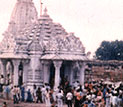 The
small hamlet of Tarnetar, about 75 kilometres from Rajkot is the site for
one of Gujarat's most well known annual fairs, the Trinetreshwar Mahadev
Fair popularly called the Tarnetar Mela. The Mela (fair) is held for three
days in the period between August to September. Like all-important tribal
fairs, it is attended by tribes from the adjoining areas of Koli, Bharwad,
Rabari, Khant, Kanbi, Kathi, and Charan who indulge in dancing,
competitive sports and other such forms of entertainment. There are over
300 stalls selling food, refreshments, exhibiting embroidery and cattle
shows. The
small hamlet of Tarnetar, about 75 kilometres from Rajkot is the site for
one of Gujarat's most well known annual fairs, the Trinetreshwar Mahadev
Fair popularly called the Tarnetar Mela. The Mela (fair) is held for three
days in the period between August to September. Like all-important tribal
fairs, it is attended by tribes from the adjoining areas of Koli, Bharwad,
Rabari, Khant, Kanbi, Kathi, and Charan who indulge in dancing,
competitive sports and other such forms of entertainment. There are over
300 stalls selling food, refreshments, exhibiting embroidery and cattle
shows.
This fair is primarily a 'marriage mart' or 'Swayamvar' for the tribal
youth of today who still visit Tarnetar, to find them a suitable bride.
The tribal youth elegantly dressed in colourful dhotis, waistcoats and
eye-catching turbans come to be chosen by village belles dressed in
colourful finery.
The bachelors are usually identified by their large colourful embroidered
umbrellas and their distinctive hairstyles. These umbrellas, which have
become emblems of the fair, are embroidered by the tribal youth for over a
year.
The fair is held around the Trinetreshwar Temple dedicated to the
three-eyed Lord Shiva, built at the beginning of the century. There is a
kund (reservoir) here and it is popularly believed that a dip in its
waters is as holy as a dip in the sacred River Ganges. The reservoir is
also known as papanshu (the destroyer of sins).
Bhavnath
Mahadev Mela 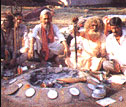 The
Bhavnath Mahadev Temple, situated at the foot of Mount Girnar in the city
of Junagadh is the site of the Bhavnath Mahadev fair held for five days in
February, during the festival of Mahashivratri. The
Bhavnath Mahadev Temple, situated at the foot of Mount Girnar in the city
of Junagadh is the site of the Bhavnath Mahadev fair held for five days in
February, during the festival of Mahashivratri.
The Mahapuja of Lord Shiva takes place at midnight in this temple on the
14th day of the dark half of the month of Magh. When the puja (prayer
ceremony) starts, Naga Bavas (naked sages) living nearby, move towards the
fair seated on elephants, holding flags and blowing conch shells. It is
firmly believed that Lord Shiva himself visits the shrine on this
occasion.
Girnar is said to be the abode of the nine Nathas (lord and protector),
who are immortal and eighty-four Siddhas (spiritually elevated souls), all
of whom also visit the temple in their invisible spiritual bodies.
Visitors are served free meals by the organizers. Special stalls sell
idols, rosaries or holy beads brought by vendors from Ayodhya and Mathura,
utensils of brass and copper, sweets and fruits. The Bhavnath Mahadev
Temple is surrounded by many equally ancient and holy places.
Vautha
Mela 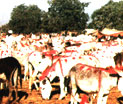 This
magnificent fair is held every year at Vautha, where two rivers, the
Sabarmati and the Vatrak meet. Like most fair sites in India, this also
has both mythological and current religious associations. This
magnificent fair is held every year at Vautha, where two rivers, the
Sabarmati and the Vatrak meet. Like most fair sites in India, this also
has both mythological and current religious associations.
The Vautha Mela site is 3 square miles in area. Legends hold that Kartik
Swami or Kartikeya, the son of Lord Shiva, visited the site. This is why
the fair is held during Kartika Purnima, the full moon night of the month
of Kartik, corresponding to November. The site, also known as Saptasangam,
is at the confluence of seven rivers. The most important Shiva temple here
is the temple of Siddhanath.
What is most significant about this fair is that it is the only major
animal trading fair in Gujarat and is on par with the famous camel fair at
Pushkar, Rajasthan. However the only animals traded here are donkeys.
About 4,000 donkeys are brought every year for sale, usually by Vanjara
(gypsy) traders.
The pilgrims who visit Vautha during the fair are from several communities
and include farmers, labourers and people belonging to several castes.
Dangs
Darbar 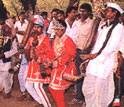 Dangs
Darbar is the name of the annual fair held every year in Ahwa, the most
important town in the Dangs a few days before Holi. The Dangs is one of
the most delightful districts of Gujarat and is located high in the
Saputara hills, the original home of the adivasis, the tribal population
of Gujarat. Dangs
Darbar is the name of the annual fair held every year in Ahwa, the most
important town in the Dangs a few days before Holi. The Dangs is one of
the most delightful districts of Gujarat and is located high in the
Saputara hills, the original home of the adivasis, the tribal population
of Gujarat.
The name 'Darbar' dates back to the time of the British, when a darbar of
Rajas and Naiks of neighbouring area used to assemble there. Today it is
called Jamabandi Darbar and the District Collector officiates at it.
Thousands of tribal people flock to Ahwa from all over the district,
dressed in bright colours sounding the Shehnai and beating their drums.
Folk dances, dramas and songs enliven the air during the festival.
Shamlaji
Melo The Shamlaji Melo, also
called the Kartik Purnima fair is held in the month of November every year
and lasts for about two weeks. It is attended by almost two hundred
thousand people from adjoining districts and even from Rajasthan.
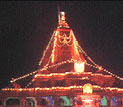 Devotees
belonging to various castes and communities including the Garasias and
Bhils throng this festival. These pilgrims come in groups, singing
devotional songs and carry religious banners to have a darshan (worship)of
the deity at the Shamlaji Temple. Devotees
belonging to various castes and communities including the Garasias and
Bhils throng this festival. These pilgrims come in groups, singing
devotional songs and carry religious banners to have a darshan (worship)of
the deity at the Shamlaji Temple.
The Shamlaji Temple is a renowned Vaishnav Shrine and the deity housed
here is known by various names included Gadadhar (bearer of the mace) and
Shaksi Gopal. The fair is also popular with the tribal people of the area,
particularly the Bhils, who revere Shamlaji, the deity they refer to as 'Kalio
Bavji', the dark divinity. The temple is of great archaeological
significance as it was built in the 11th century. Apart from a darshan of
the deity in the temple, the pilgrims consider a bath in the river Meshwo
essential.
Top
|
|



